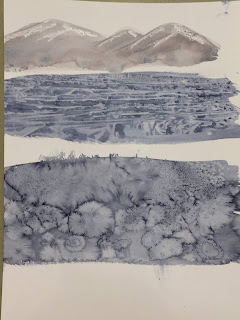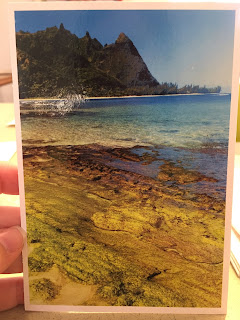 |
| the professor's demonstration in class |
In today's watercolor class, we learned to use candle wax, saran wrap, and salt (table salt, rock salt, or margarita salt) to create textured effects in our watercolors. The professor called today's lesson "Gimmicks." I had such fun trying them all out.
In class I came up with a quick little picture to illustrate all three techniques. This is a project I could use with 4-H kids, and I bet they'd enjoy playing with the different mediums. It also demonstrates shading, as I mixed three different green colors for the tree itself.
The first of the instructor's techniques that she demonstrated was using plain wax from a normal tapered candle. Using the candle as a pencil before applying any paint creates a resist, where the waxed areas will not accept the paint. The instructor demonstrated this by using wax to portray snow on her mountaintops. In my little holiday tree painting, I used wax to highlight an area of the star where I wanted some shine.
In the second technique demonstrated, paint is first applied. While the paint is wet, a piece of saran wrap is "stretched" so that it gets small lateral folds in the plastic wrap. this is laid on top of the area, and smoothed out by hand. I should have taken a photo of the plastic wrap while it was lying on my painting. Once dry, or at least mostly dry, the plastic wrap is lifted off of the painting, leaving texture to the paint. The instructor demonstrated this technique as a way to add life to water, whether horizontal, or vertical as in a waterfall. In my painting I used it to give texture to my tree boughs. The photo doesn't show it well but there is actually texture to all three shades of green.
Lastly, the instructor had salt in three different gradients for us to play with as a way to add texture. Table salt, Margarita salt, and Rock salt were shaken lightly across wet paint. Instantly, the salt would soak up the pigment. After the painting has dried, the salt can be wiped away. If left on a finished work displayed over time, the sodium could eat into a canvas. In a casual painting such as my holiday one, I found no need to wipe it away. I liked the rough texture left on the tree trunk in my painting.
 |
| the sample painting from the instructor that was my assignment to copy. |
I was supposed to spend the class time painting one of the instructor's samples that could be used to demonstrate the techniques she had shown us. But after doing my simple original drawing, I didn't have a lot of time to do a full-blown assignment.
I spent 30 minutes or so doing a quick impression of the painting above, and used some salt to make the colors bleed a little. Next week, I'll play along a bit better with the assignment.

































